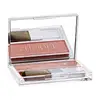What's inside
What's inside
 Key Ingredients
Key Ingredients

 Benefits
Benefits

No benefits
 Concerns
Concerns

 Ingredients Side-by-side
Ingredients Side-by-side

Mica
Cosmetic ColorantNylon-12
Polymethylsilsesquioxane
Methyl Methacrylate Crosspolymer
Silica
AbrasiveCalcium Stearate
Cosmetic ColorantSqualane
EmollientKaolin
AbrasiveMagnesium Carbonate
AbsorbentLauroyl Lysine
Skin ConditioningPropylene Glycol Dicaprylate/Dicaprate
EmollientTriethoxycaprylylsilane
Caprylyl Glycol
EmollientHexylene Glycol
EmulsifyingTetrasodium EDTA
Phenoxyethanol
PreservativeCI 77891
Cosmetic ColorantCI 77491
Cosmetic ColorantCI 77492
Cosmetic ColorantCI 77499
Cosmetic ColorantMica, Nylon-12, Polymethylsilsesquioxane, Methyl Methacrylate Crosspolymer, Silica, Calcium Stearate, Squalane, Kaolin, Magnesium Carbonate, Lauroyl Lysine, Propylene Glycol Dicaprylate/Dicaprate, Triethoxycaprylylsilane, Caprylyl Glycol, Hexylene Glycol, Tetrasodium EDTA, Phenoxyethanol, CI 77891, CI 77491, CI 77492, CI 77499
Talc
AbrasiveDimethicone
EmollientSilica
AbrasiveZinc Stearate
Cosmetic ColorantNylon-12
Lauryl Laurate
Skin ConditioningTetrasodium EDTA
Potassium Sorbate
PreservativeChlorphenesin
AntimicrobialMica
Cosmetic ColorantCI 77891
Cosmetic ColorantIron Oxides
CI 77163
Cosmetic ColorantCI 19140
Cosmetic ColorantCI 75470
Cosmetic ColorantCI 15850
Cosmetic ColorantCI 77510
Cosmetic ColorantCI 42090
Cosmetic ColorantCI 45380
Cosmetic ColorantCI 12085
Cosmetic ColorantCI 77742
Cosmetic ColorantCI 73360
Cosmetic ColorantCI 17200
Cosmetic ColorantCI 45410
Cosmetic ColorantCI 15880
Cosmetic ColorantCI 77007
Cosmetic ColorantCI 15985
Cosmetic ColorantIngredients Explained
These ingredients are found in both products.
Ingredients higher up in an ingredient list are typically present in a larger amount.
Ci 77891 is a white pigment from Titanium dioxide. It is naturally found in minerals such as rutile and ilmenite.
It's main function is to add a white color to cosmetics. It can also be mixed with other colors to create different shades.
Ci 77891 is commonly found in sunscreens due to its ability to block UV rays.
Learn more about CI 77891Mica is a naturally occurring mineral used to add shimmer and color in cosmetics. It can also help improve the texture of a product or give it an opaque, white/silver color.
Serecite is the name for very fine but ragged grains of mica.
This ingredient is often coated with metal oxides like titanium dioxide. Trace amounts of heavy metals may be found in mica, but these metals are not harmful in our personal products.
Mica has been used since prehistoric times throughout the world. Ancient Egyptian, Indian, Greek, Roman, Aztec, and Chinese civilizations have used mica.
Learn more about MicaNylon-12 is a polymer. It is derived from 12-aminododecanoic acid, an omega-amino fatty acid
According to a manufacturer, it is a talc substitute. Like talc, nylon-12 gives products a satin feel. The manufacturer also claims this ingredients does not block pores and has moderate oil absorption.
This ingredient may not be reef-safe.
Learn more about Nylon-12Silica, also known as silicon dioxide, is a naturally occurring mineral. It is used as a fine, spherical, and porous powder in cosmetics.
Though it has exfoliant properties, the function of silica varies depending on the product.
The unique structure of silica enhances the spreadability and adds smoothness, making it a great texture enhancer.
It is also used as an active carrier, emulsifier, and mattifier due to its ability to absorb excess oil.
In some products, tiny microneedles called spicules are made from silica or hydrolyzed sponge. When you rub them in, they lightly polish away dead skin layers and enhance the penetration of active ingredients.
Learn more about SilicaTetrasodium EDTA is the salt formed from neutralizing ethylenediamine tetraacetic acid with sodium hydroxide. It is a chelating agent and used to prevent metal ions from binding to other ingredients. This helps keep the product and ingredients stable.
Tetrasodium EDTA comes as a white solid and is soluble in water.